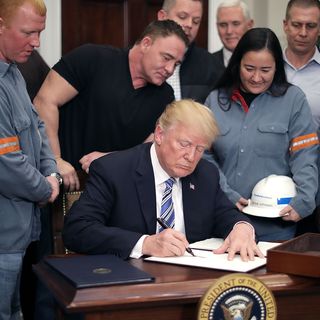The World Trade Organization (WTO) last week agreed to investigate the United States’ tariffs on steel and aluminium in response to complaints from seven affected members, as well as US complaints against their retaliatory measures and China’s treatment of foreign intellectual property. These disputes will be critical tests of the multilateral trading system and have far-reaching implications for the global economy and Australia’s future prosperity.
The WTO faces a crisis of legitimacy that stems from its failure to progress multilateral trade liberalisation since the Doha round of negotiations commenced in 2001, as well as the US view that its binding dispute settlement mechanism has over-reached its authority, has displaced the WTO’s negotiation function and is ill-equipped to handle China.
The WTO faces a crisis of legitimacy that stems from its failure to progress multilateral trade liberalisation since the Doha round of negotiations commenced in 2001.
This week, Australia joined 12 other WTO members in proposing reforms that are designed to avert a crisis in the WTO’s dispute settlement mechanism that has seen the United States block new appointments to the WTO’s Appellate Body. The body is down to three out of seven members, the minimum required to hear an appeal against a WTO ruling, with two of those retiring at the end of 2019. If the United States continues to block new appointments, an important element of the dispute settlement mechanism will cease to function.
Whether the proposed reforms, which will be presented to the WTO General Council meeting on 12 December, are sufficient to satisfy US concerns remains to be seen. Many in the Trump administration want to turn back the clock to the pre-WTO system of non-binding dispute resolution.
As it stands, the WTO dispute settlement mechanism will have its work cut out for it in 2019. One issue it will have to contend with is whether the United States can invoke the national security exception under Article XXI of the General Agreement on Tariffs and Trade to justify its tariffs on steel and aluminium, and its threatened tariffs on automotive imports.
The national security exception is self-judging and the multilateral trading system has always relied upon members to exercise restraint in its use. The United States maintains that once national security is invoked, the WTO no longer has jurisdiction (a position it shares with Russia).
The affected members will argue that the tariffs have a different motivation and fall under a different set of rules. If the WTO were to endorse the US position, it would open the floodgates to the abuse of the national security exception by other countries.
China’s renewed authoritarian turn since 2012 and re-embrace of a state-led development model has put China increasingly at odds with the rest of the world and not just the United States.
Although the national security exception is self-judging and so cannot be deemed a violation of WTO obligations, it does have specific wording which could be interpreted to rule against the United States. The Trump administration would view this as another instance of the WTO acting against US interests.
The United States could ignore the ruling or even withdraw from the WTO. President Trump has reportedly ordered the drafting of legislation to this effect, reflecting his view that the WTO “is the worst organisation ever created”.
While it is an open question whether the president could withdraw from the WTO without congressional approval, it is possible that a majority of Congress might come to agree. US law already provides for a Congressional vote on WTO membership in the 2020 election year. Withdrawal from the WTO would allow the president to revert to the Smoot-Hawley tariff schedule of 1930, while freeing other countries to discriminate against the United States with retaliatory tariffs.
Donald Trump and US tariffs: A 1930s-style trade war will be hard to avert

China’s 2001 accession to the WTO was widely viewed as a mechanism through which China would converge on the norms underpinning the multilateral trading system. China’s renewed authoritarian turn since 2012 and re-embrace of a state-led development model has put China increasingly at odds with the rest of the world and not just the United States.
China is on the receiving end of a growing proportion of WTO litigation. Yet the Trump administration has brought only one new case against China since coming to office and its tariffs-first policy has resulted in China raising its trade barriers, not lowering them. The Trump administration would be better served joining other countries in throwing the WTO rule book at China. This would force China to either comply with the rules or put itself outside the global trading system.
Australia has long supported the WTO and the multilateral trading system, but has also made criticisms of the dispute settlement process similar to those of the United States. The risk is that the current US administration walks away from the WTO in response to the trade disputes initiated last week before the other members can agree, much less implement, substantive reforms.
How these disputes play out over the next two years will be critical to the survival of the multilateral trading system that has underpinned the world’s, as well as Australia’s, prosperity






